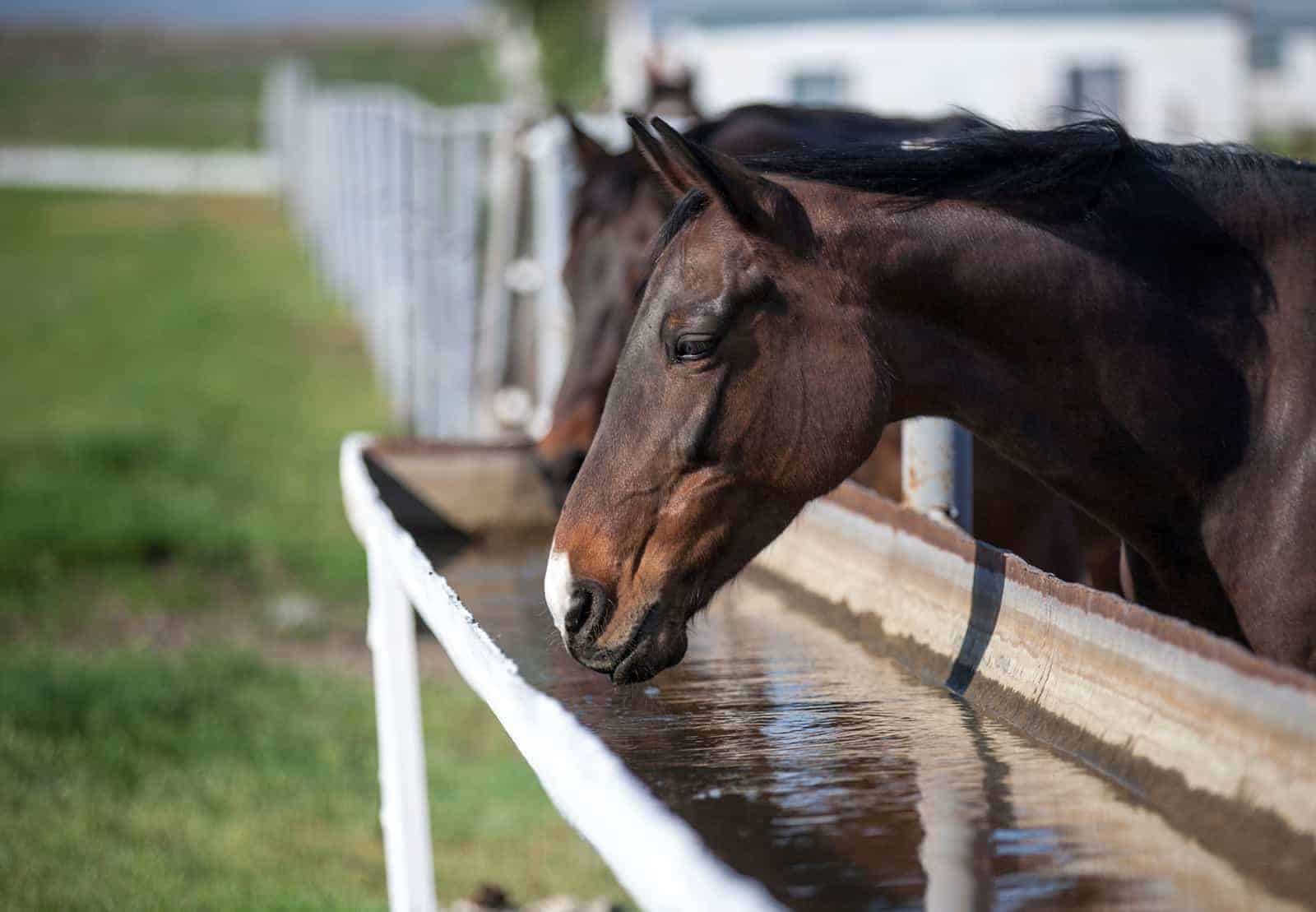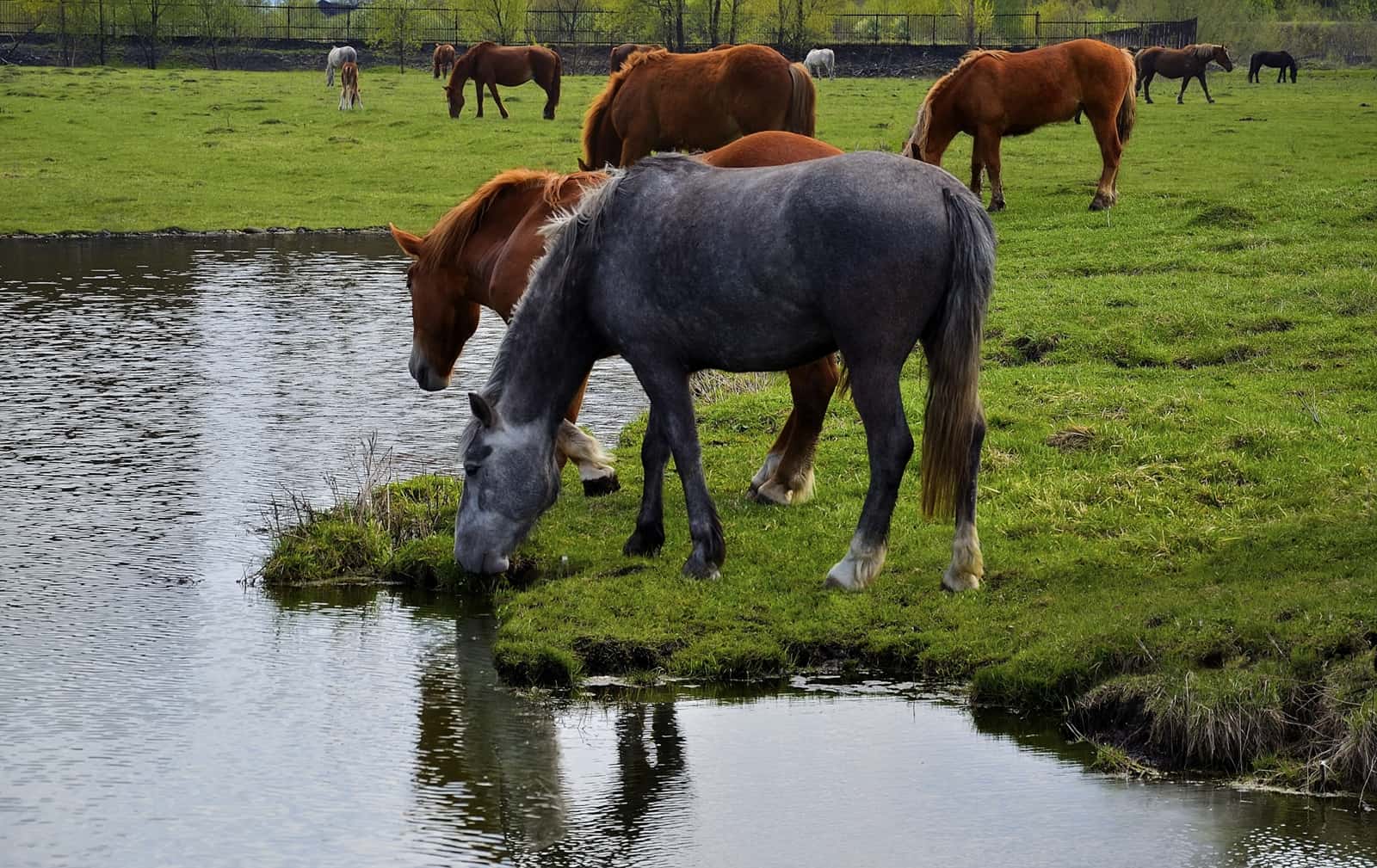Your Horse’s Water Sources: Things to Consider

Making fresh, clean water available to your horse might seem like a very basic thing, but it’s not always as simple as it sounds. Water completely untouched by chemicals or minerals doesn’t exist in nature. Water is, after all, the universal solvent, with a unique ability to pick up and dissolve virtually everything it encounters. These other substances contained in drinking water aren’t necessarily bad; minerals dissolved in water impart much of its flavor, after all, and many are even beneficial (such as fluoride in city water supplies). The issue with dissolved substances isn’t so much purity as it is safety—in other words, it’s not whether they are present, but whether they are present in toxic amounts.
If you live in suburbia, your barn may draw its water from a public or municipal system that provides extensive purification and filtration services and also regularly tests its water for contaminants such as disease-causing bacteria, toxic chemicals, and even radioactive elements such as radon. Worries are few with this sort of system, but that doesn’t mean there’s no possibility of contamination; the testing is done at the source, and if there is damage to the delivery line or a problem with the plumbing on your property, your water could still be compromised.
More diligence is required if, like the majority of horse people, you draw your barn’s water from a well. Many wells provide beautifully clean water, but there is also the potential for contamination. The same is true if your horse gets his water from a natural source, such as a stream or pond in your pasture. Fortunately, horses are well adapted to dealing with less-than-pristine water sources.
Like us, however, their water intake can quickly be adversely affected if the water’s taste is unpleasant. Horses that refuse to drink from unfamiliar-tasting water sources are distressingly common (so much so that most of us are familiar with the trick of flavoring water with anything from peppermint oil to powdered kids’ drinks to disguise the taste when these finicky horses are away from home).
The single most reliable indicator of water quality in your barn is the total amount of dissolved solids (TDS), a number that can easily be determined with a water test run by your county or state health laboratory, your local agricultural extension agent, or the Environmental Protection Agency. The TDS is the sum of the concentrations of all organic and inorganic substances dissolved in the water, including mineral salts, algae, bacteria, nitrates, and solid particles of debris.
Between 1,000 and 2,999 parts per million TDS is considered satisfactory for livestock, with around 6,000 ppm the usual upper limit for safe drinking water for horses. At levels above 1,000 ppm, your water may have an offensive smell, taste, or color—and a 1998 study conducted by the Equine Research Centre in Guelph, Ontario, found that equine diarrhea is a common complaint on farms with water TDS levels in excess of 1,000.
Testing your well’s water for bacterial contamination on an annual basis is sound practice. A total coliform test checks the water for bacteria normally found in the soil, in surface water, and in human and animal waste. Coliform bacteria are not, in themselves, considered harmful, but their presence in your water supply is an indication that your well may be contaminated either from run-off from a manure pile, from a nearby septic bed or tank, or from fertilizer or manure spread on a nearby farmer’s field. Coliform levels can rise in drought conditions, with sudden heavy rainfalls, or with any unusual change in weather patterns. It’s also possible to have high coliform levels when the well has developed physical defects, such as a broken or missing cap that could allow debris, surface water, insects, or rodents inside.
Doing bacterial testing is a good idea whenever there is a noticeable change in the color, odor, or taste of your water; when any animal or person on your farm becomes sick from a disease such as Potomac horse fever or Salmonella; when the water supply system on your farm has been disassembled for repairs; when spring flooding occurs near your well; or when the cap or the interior of the well has been damaged.
Wells that are correctly drilled, sealed, and more than 50 feet deep generally have less chance of becoming contaminated with bacteria. Water from an old or shallow well should be tested more frequently. Don’t rely on “clean” tests from a neighbor’s well. Even two wells side by side can draw water from separate aquifers (underground water sources) and yield very different results.
Other Contaminants
Well water often contains significant concentrations of dissolved minerals that can influence the taste, smell, and palatability of your water. (The classic example is “sulfur water,” which has that unmistakable rotten-egg stench.) Your local lab can test your water for levels of calcium, magnesium, manganese, iron, copper, zinc, sodium, chloride, and lead, as well as sulfates and nitrates (nitrate contamination is particularly common on horse farms; its likely source, your manure pile). Concentrations of these minerals, if sufficiently high, can also have an impact on your horse’s dietary balance, as levels of one mineral in his gut can often influence his ability to absorb another.
Some minerals, such as iron, calcium, and magnesium, are chiefly a concern because they can clog your plumbing with scale and deposits and change the water’s color and taste. Other minerals, such as lead, are more worrisome because they can build up to toxic levels.
An acidity/alkalinity test is another frequently performed water analysis. Water testing below pH 6.5 is considered acidic and can contribute to the corrosion of your pipes. (Acidic water isn’t necessarily as nasty as it sounds, however—a can of carbonated soda may be up to 100 times more acidic than water with a pH of 5.0.) On the other hand, if your water tests at pH 8.5 or higher, it has a lot of alkaline, which means you probably have crusty mineral deposits on your pipes and fixtures. A sudden change in your water’s pH can be a heads up for damage to your well as the pH levels in water usually fluctuate very little over time.

Blue-green algae occasionally bloom in ponds in hot, dry weather and can be a concern if your chief water source is above ground. Blue-green algae poisoning can cause muscle tremors, labored breathing, bloody diarrhea, liver damage, and even convulsions and death, so it’s best to remove horses from a contaminated water source with algal blooms immediately. Algal growth is usually associated with large amounts of organic material in the water, often as a result of runoff from nearby fertilized fields.
When it comes to water safety, pesticides and herbicides are other worries. Though expensive, testing for these chemicals may be worth doing if you have significant concerns about the agricultural sprays being used in your area. Likewise, if you suspect solvents or other toxic chemicals may have leached into your water supply from a local industrial site, get your water tested for your own peace of mind.
Guidelines for Testing
- If your water has an unpleasant smell or your horses refuse to drink it, test for the following: pH, copper, lead, iron, zinc, sodium, chloride, TDS, and hydrogen sulfide.
- If your water is cloudy and frothy, test for turbidity (cloudiness, caused by mud, algae, and solids), TDS, and detergents.
- If you live near a road salt storage site, a street that is heavily salted in winter, or the ocean, test for sodium and chloride levels.
What should you do if your water tests reveal an imbalance or contamination? Consult the lab that did your testing for its recommendations, and try these tactics:
- Improve the protection for your well, giving it a weatherproof, sanitary seal and eliminating access for debris, insects, and rodents;
- Eliminate the source of the contamination (i.e., remove or relocate the manure pile); and
- Treat the water with chemicals or filtration to improve its quality, if that’s what your lab recommends.
When all else fails, you may have to drill a new well. Newer, deeper wells with good seals are far less problematic than older, shallower wells that may be chronically contaminated. Though the cost of a new well can be considerable, it will benefit you and your horses in the long run.
Manure Pile Management
If high coliform levels turn up in your well water, it’s possible your own manure management is to blame. To protect your groundwater, make sure you situate your manure pile in an elevated, well-drained location, not on the lowest spot on the property. After a rainstorm, watch the flow of water—it should go around your manure pile, not through it. Simply rerouting the flow of run-off water can improve your water quality considerably. Make sure, too, that the natural run-off from your manure pile doesn’t head directly toward any ponds or streams. Finally, don’t park your manure pile in a paddock where your horses can climb over and through it all day. They’ll pack it and spread it over a greater area, increasing the probability of water contamination.
Written by:
Karen Briggs
Related Articles
Stay on top of the most recent Horse Health news with



















